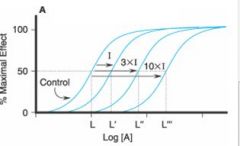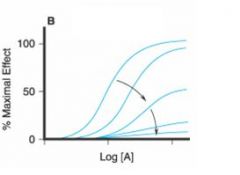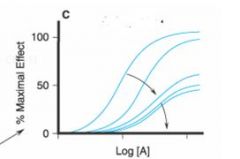![]()
![]()
![]()
Use LEFT and RIGHT arrow keys to navigate between flashcards;
Use UP and DOWN arrow keys to flip the card;
H to show hint;
A reads text to speech;
14 Cards in this Set
- Front
- Back
|
What are the 4 types of drug receptors?
|
Ligand gated ion channel (IONOTROPIC
G-protein coupled (METABOTROPIC) Kinase-linked receptors Nuclear receptors |
|
|
Define ED50
|
1/2 maximal response
|
|
|
define Emax
|
maximal response
|
|
|
Define EC50
|
the conc of an agonist giving 50% of the maximal response
|
|
|
describe drug-receptor interactions effect on equilibrium
|
e. The drug-receptor interaction can either move equilibrium towards and increase or decrease in affinity. Agonists will favor the binding of a drug to a receptor and antagonist will reduce the affinity.
f. At equilibrium, receptor occupancy is related to drug concentration. The higher the affinity of the drug for the receptor, the lower the concentration at which it produces a given level of occupancy, but not necessarily greater effect. g. In the resting state (when there is not a ligand bound to the receptor) the equilibrium normally favors the resting state. h. When a full agonist binds preferentially to the activated state, it shifts the equilibrium towards activation. An agonist initiates changes in cell function. Full agonists produce maximal effects, while partial agonists produce only submaximal effects. i. A partial agonist shows less selectivity and shifts the equilibrium to a smaller extent, even when receptors are fully occupied. j. An antagonist shows no preference and does not shift the equilibrium, though it reduces the effect of an agonist by preventing the agonist from binding to the receptors. An antagonist binds to receptors without initiating changes in cell function |
|
|
Signaling molecule actually doesn't ___A___, uses cascade of events to ___B___ cellular change. Use receptors on ___C___ which are usually coupled to ___D___ on the __E___surface of the membrane. (D) then __F__es another molecule, usually ___G___ which carries further action.
|
A- enter the cell
B - induce C- plasma membrane D - kinase e -inner F - phosphorylates G - cAMP |
|
|
from an LDR curve, what is the X axis? what is the Y-axis?
Where do you gain info of the efficacy? the potency? |
x = dose of drug
Y = % maximal response x = potency y = efficacy |
|
|
if an LDR curve shows 2 parallel lines, the 2 drugs have similar____
|
mechanism of action
|
|

what does this LDR curve illustrate?
|
reversible competitive inhibition
|
|

what does this LDR curve illustrate?
|
irreversible competitive inhibition
|
|

what does this LDR curve illustrate?
|
allosterism w/ potentiation
|
|

what does this LDR curve illustrate?
|
non-competitive allosterism w/ antagonism
|
|
|
A ____antagonist has the opposite physical effect of a drug
|
physiological
|
|
|
a____antagonist effcts the absorption/metabolism of another drug
|
pharmacokinetic
|

